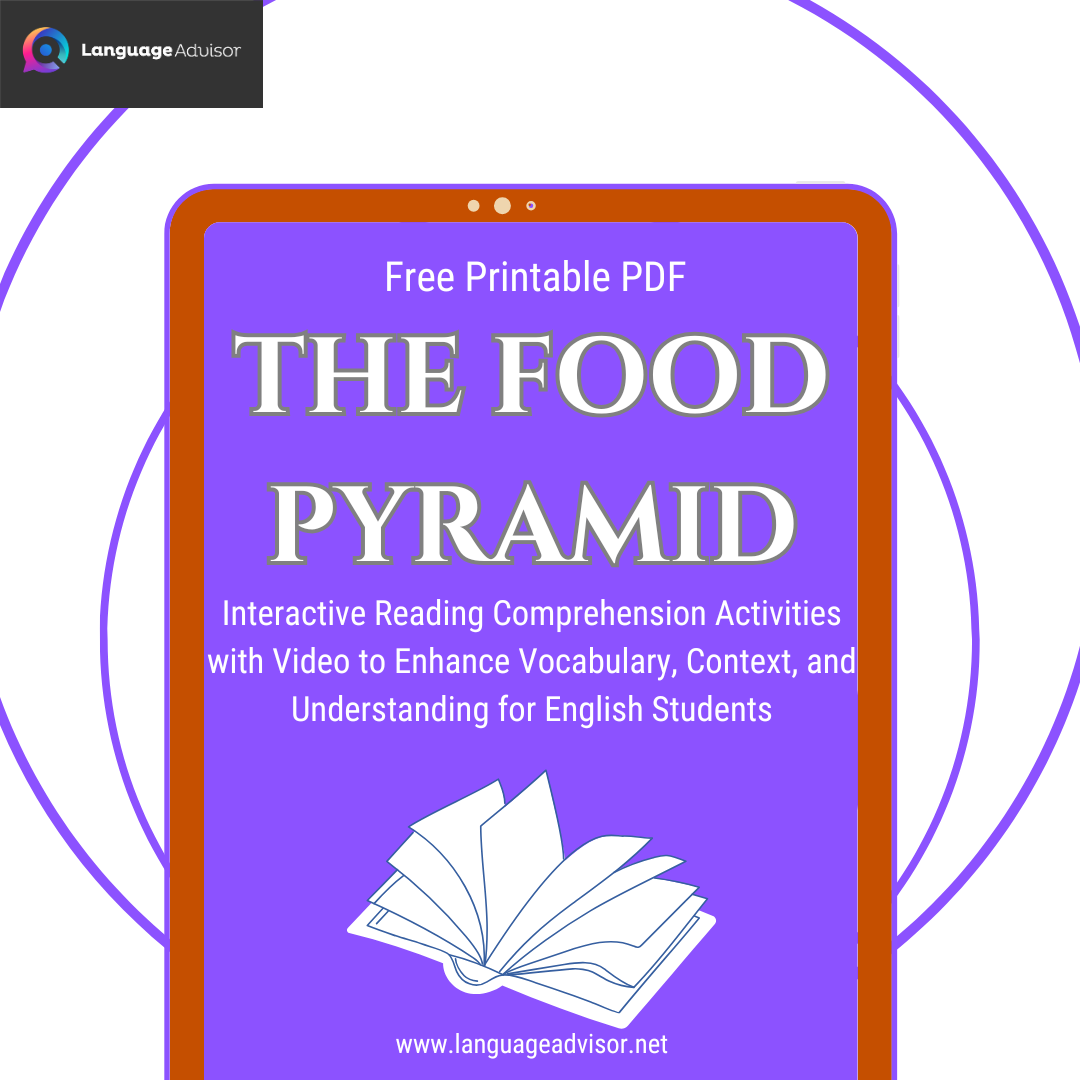The Food Pyramid. Interactive Reading Comprehension Activities with Video to Enhance Vocabulary, Context, and Understanding for English Students. Free Printable PDF
The Food Pyramid

Improving reading comprehension is a vital skill for English learners at all levels. It goes beyond just understanding the words on the page, but also involves grasping meaning, context, and intent behind a text. One effective way to enhance reading comprehension is by integrating videos alongside written exercises. Video content can provide visual cues, context, and engagement that help reinforce the learning process. In this blog post, we’ll explore a fun and interactive reading comprehension activity that combines written passages with video resources to deepen understanding and make learning more enjoyable.

The Food Pyramid – Reading Comprehension
In 1988 Oprah pulled out a red wagon full of greasy animal fat to show her audience how much weight she had lost. It was pretty gross. But it became her highest rated episode ever. Back then fat was the enemy. It was increasingly being seen as the root cause behind America’s steady rise in obesity and diabetes.
So when the food pyramid came out in 1992 it was intended to help Americans fight back by officially recommending a low fat diet for better health. But decades later the fallout from the food pyramid may have accidentally made our diets less healthy. And quite possibly made the obesity and diabetes problem even worse. This is the story of how we got the food pyramid so wrong.
To address America’s mounting obesity, diabetes and heart disease problems in the ’80s, policymakers looked to what had worked before on a different public health menace: smoking. Back in 1964, the Surgeon General’s Office published a landmark report that established a link between smoking and cancer. In the following years rates of smoking fell dramatically and tobacco related cancers started declining. It was a watershed moment in public health and the report was widely credited with helping to save millions of lives.
So to try and recreate some of that success, in 1988 the Surgeon General’s Office published a 700 page report to help fix our diet. The Surgeon General boasted that the depth of the science was even more impressive than the legendary smoking study. It was the first time officials identified the reduction of fat as the number one dietary priority. And when the USDA food pyramid came out four years later it reflected that. Fat was crammed into the tippy-top along with a warning to only use it sparingly, whereas a host of carbohydrate-rich foods occupied the pyramid’s wide bottom layer.
The message it sent was simple and clear: carbohydrates good, fat bad. The food pyramid spread far and wide. It was in schools, on posters, in our homes, and on our minds. It was the most widely adopted guideline for healthy eating in the history of the United States. Over a decade after it came onto the scene a Gallup survey found that 82% of Americans believed the pyramid was the basis of a sensible, healthful eating plan.
But despite the pyramid’s notoriety and years of educating the public about nutrition, Americans didn’t seem to be getting any healthier. Obesity and diabetes were continuing to climb. So what was going on? Well, first of all it turns out that the food pyramid’s use fat sparingly caution was an oversimplification from the start.
Research today makes a pretty strong case that not all fats are created equal. And some fats are actually good. In fact too little good fat could actually be leading to heart disease and obesity. The very problems the food pyramid had been developed to prevent. And the problems with oversimplification didn’t end there.
The wide bottom of the pyramid gave many the impression that eating a diet with lots of carbs was good without distinguishing between complex carbs found in whole grains and oats and simple carbs found in things like white bread and baked goods, which your body quickly turns into waist-expanding sugar. The pyramid’s authors actually knew this at the time but they thought keeping their guidelines simple was important so they left that part out.
And the decision proved to be a fateful one. The pyramid’s low fat, high carb recipe would end up contributing to a low fat diet craze that was about to sweep the nation. Sensing the growing anti-fat sentiment in the ’80s and ’90s the food industry responded by developing thousands of reduced fat products. Yogurt, chips, meats, cheeses, and cookies.
By 2005 low fat and fat free products were a 35 billion dollar market. the largest segment of the diet food industry. But there was a catch; when food manufacturers took out the fat they had to replace it with something that still made it taste good, which almost always meant adding extra sugar and carbohydrates.
Compared to the late ’70s, today we eat around 60 more pounds of grains and 30 more pounds of sweeteners every year. At the same time, we’re eating up to 400 more calories per day. In recent years there are signs that perspectives are changing. In 2015 the official dietary guidelines eliminated its limits on cholesterol. And the American Heart Association has gradually revised its guidelines and moved away from its strict guidance to lower fat intake.
The bottom line is that nutrition is complex. And despite collective efforts of some of the planet’s best minds the science of nutrition is still young and evolving. The number of annual studies on obesity and diabetes alone has risen from about 1,000 in 1960 to 44,000 in 2013. It’s likely that more than a million articles have been published on dieting over the last 50 years.
Given all the complexity perhaps the food pyramid’s greatest mistake was in its inception because an oversimplified, one size fits all recommendation is a pretty surefire recipe for getting things wrong.
| Word | Meaning |
| root cause | |
| obesity | |
| fallout | |
| menace | |
| landmark report | |
| a watershed moment | |
| sparingly | |
| notoriety | |
| strong case | |
| oversimplification | |
| waist-expanding | |
| fateful | |
| The bottom line | |
| one size fits all | |
| surefire | |
| came onto the scene |
Questions:
What significant event in 1988 helped Oprah Winfrey achieve her highest-rated episode?
a) She pulled out a wagon full of animal fat to show her weight loss
b) She launched the USDA food pyramid
c) She discussed the risks of carbohydrates
d) She endorsed a high-fat diet
What was the food pyramid’s main recommendation in 1992?
a) High-fat diet
b) Low-carbohydrate diet
c) Low-fat diet
d) High-protein diet
According to the passage, what mistake did the food pyramid make?
a) It promoted too much fat intake
b) It did not distinguish between different types of carbohydrates
c) It recommended too much sugar
d) It encouraged people to eat more meat
Why did food manufacturers add sugar and carbohydrates to low-fat products?
a) To increase the nutritional value
b) To enhance the taste after removing the fat
c) To make the products healthier
d) To follow the USDA guidelines
What does recent research say about fats?
a) All fats are bad for health
b) Some fats are beneficial and too little can be harmful
c) Fats are the primary cause of obesity
d) Fats should still be avoided at all costs
How did the food pyramid influence public perception of carbohydrates?
a) It discouraged carbohydrate consumption altogether
b) It presented all carbohydrates as healthy
c) It encouraged people to eat simple carbs only
d) It warned against both simple and complex carbs

Watch the video

Using video in reading comprehension activities not only enhances students’ engagement but also aids in building critical language skills such as listening, vocabulary development, and contextual understanding. By incorporating multimedia into traditional reading lessons, teachers can cater to various learning styles and keep students motivated. We encourage you to try out this method and observe how it transforms reading into a more dynamic, interactive experience for your English learners.

DOWNLOAD THE PDF FOR FREE





